
Module 1 lecture slides created to support Biology 101 and to be used alongside OpenStax Biology 2e.


Module 1 lecture slides created to support Biology 101 and to be used alongside OpenStax Biology 2e.
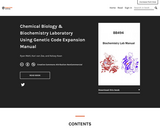
Chemical Biology & Biochemistry Laboratory Using Genetic Code Expansion Manual

Interactive radiology images, animated modules showing the physiology of difficult to understand muscle groups, sketches of anatomy, and links to the already existing quality neuroanatomy website.
Covers:
Head and Neck
Anatomy Videos
Back and Core
Thorax
Radiological Atlas
Abdomen
Upper Limb
Anatomical Illustrations
Lower Limb
Embryology
Neuroanatomy
Pelvis

Cocaine afflicts many individuals and is potently addictive. Originally hailed as a wonder-drug in the late 19th century, cocaine is now considered an illegal substance. Cocaine’s addictive properties can be attributed to changes in the dopamine reward pathway of the Ventral Tegmental Area and Substantia Nigra, Prefrontal Cortex, Dorsal Striatum, Nucleus Accumbens, Amygdala, Globus Pallidus, and Hippocampus. This drug affects the brain in two processes: binge and crave. The binge process highlights cocaine’s ability to block dopamine reuptake from the synapse resulting in hyperstimulation of the postsynaptic neuron in the dopamine reward pathway. The crave process promotes drug-seeking behavior through conditional and contextual cues. Understanding the effects of cocaine in the brain may grant insight in creating future medication and therapies to treat individuals addicted to this drug.
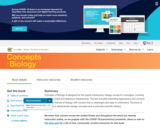
Concepts of Biology is designed for the introductory biology course for nonmajors taught at most two- and four-year colleges. The scope, sequence, and level of the program are designed to match typical course syllabi in the market. Concepts of Biology includes interesting applications, features a rich art program, and conveys the major themes of biology.

In this survey text, directed at those not majoring in biology, we dispel the assumption that a little learning is a dangerous thing. We hope that by skimming the surface of a very deep subject, biology, we may inspire you to drink more deeply and make more informed choices relating to your health, the environment, politics, and the greatest subject that are all of us are entwined in, life itself. This text also includes 80 interactive H5P activities that you can use to evaluate your understanding as you go.
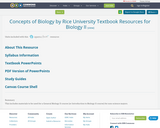
This resource contains materials for chapters 11-15 and 19-21 from the Concepts of Biology OpenStax OER book by Rice University. It includes materials to be used for a General Biology II course (or Introduction to Biology II course) for non-science majors.
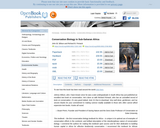
Conservation Biology in Sub-Saharan Africa comprehensively explores the challenges and potential solutions to key conservation issues in Sub-Saharan Africa.
Easy to read, this lucid and accessible textbook includes fifteen chapters that cover a full range of conservation topics, including threats to biodiversity, environmental laws, and protected areas management, as well as related topics such as sustainability, poverty, and human-wildlife conflict. This rich resource also includes a background discussion of what conservation biology is, a wide range of theoretical approaches to the subject, and concrete examples of conservation practice in specific African contexts. Strategies are outlined to protect biodiversity whilst promoting economic development in the region.
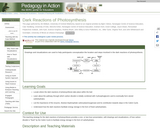
The dark reactions of photosynthesis (Calvin Cycle) are presented in this learning experience to show where these processes take place in the plant as well as the specific reactions involved.

During this lab, students determine the salinity of collected water samples. They also compare the effect of the solute concentration of their samples with that of solutions of known solute concentrations on plant cells.
![Digital Storytelling [Natural Sciences]](https://vivaopen.oercommons.org/static/newdesign/images/materials/default-thumbnail-index.png)
A well-crafted and executed storytelling assignment can serve as an efficient and engaging learning activity which targets the three highest levels of Blooms‰Ûª taxonomy which are to Create, Evaluate and Analyze. This digital storytelling assignment is part of a signature assignment series (Stage 1) conducted in all courses of the First Year Seminar for Natural Sciences (NSF101). Students begin collecting pictures and videos for their assignment from the 3rd week of the semester on a flash drive. During the fourth week of the semester, the instructor first describes the storytelling process and stages. This is followed by learning around how storytelling can be used as a narrative, to foster inquiry learning, content-based information.
In studio hour, the First Year Seminar Student Success Mentors enable students to familiarize themselves with the digital tools necessary to create their digital stories such as iMovie, narrated PowerPoint, Prezi and Powtoon (to name a few). Next, students submit a draft of their scripts, which is edited by the professor, and then students submit their final digital story. The prompts for the script ask students to reflect on their journey thus far and project forward into their future career aspirations. It also asks them to connect their content learning between courses and co-curricular experiences. The prompts within the assignment directly articulate the Student Learning Objectives of the Biology and Environmental Science Program (please see Table 1) Students complete this assignment within ePortolio assignment templates. Link to the assignment template can be found here https://lagcc-cuny.digication.com/nsf101-digital-storytelling/home-1.
This assignment has been through multiple assignment development and revision charrettes as part of the Programmatic Integration Meeting in the Natural Sciences Department funded by the Learning Matters mini-grants from the Center for Teaching and Learning at LaGuardia Community College.
LaGuardia‰Ûªs Core Competencies and Communication Abilities

Earth Law and the Rights of Nature: A New Generation of Laws Built for Nature Wilson, Grant, Kayman, Lindsey, Bartlett, Paul, and Milena Popov John Jay College of Criminal Justice, Earth Law Center, Environmental Education Fund
Forget doom and gloom. Let’s educate students about the Rights of Nature, an inspiring, evolving legal development which is gaining traction in the US and around the world, and which can promote the cultural shift needed to address our overlapping intersecting environmental crises — climate change, accelerating species extinction, and ecosystem collapse. The Rights of Nature is one aspect of Earth Law. Some of the other specific movements falling under the banner of Earth law are nonhuman rights for animals, defining ecocide as a crime, rights of future generations, legal guardianship for nature, and Indigenous legalities. In most countries, Nature has the legal status of mere property. The Rights of Nature recognizes that humans and Nature are in a relationship, rather than Nature merely providing a hoard of natural resources for indiscriminate human use. The legal structures discussed in Rights of Nature literature codifies the details of this restored relationship, rather than actually creating it. Nature becomes a legal entity with basic rights: the right to exist, flourish, thrive and regenerate. The Rights of Nature can also complement Indigenous rights by empowering Indigenous peoples to serve as legal guardians of their traditional territories. This poster and a companion open access CUNY Commons webpage and repository will provide links to curated video clips, films, case studies, a course book, a graduate level course syllabus, mock trial workshops, and written materials that can be used for incorporating the Rights of Nature and complimentary legal movements concepts into curricula.
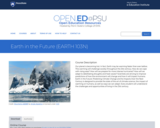
Our planet is becoming hot. In fact, Earth may be warming faster than ever before. This warming will challenge society throughout the 21st century. How do we cope with rising seas? How will we prepare for more intense hurricanes? How will we adapt to debilitating droughts and heat waves? Scientists are striving to improve predictions of how the environment will change and how it will impact humans. Earth in the Future: Predicting Climate Change and Its Impacts Over the Next Century is designed to provide the state of the art of climate science, the impact of warming on humans, as well as ways we can adapt. Every student will understand the challenges and opportunities of living in the 21st century.

Introduction to the basic principles of ecology and evolutionary biology emphasizing quantitative approaches and hypothesis testing. Scientific reasoning, computer literacy, and writing skills are developed in the laboratory.
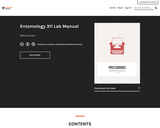
Labs in this book supplement the information gained in lecture, as well as providing some perspective and experience with hands-on applications of ideas in pest management. The labs are presented in week-by-week order, so the pre-labs and reading for week 1 are labeled “Pre-Lab 1” and “Week 1 Reading”.
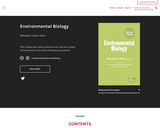
This open textbook covers the most salient environmental issues, from a biological perspective. The text is designed for an introductory-level college science course. Topics include the fundamentals of ecology, biodiversity, pollution, climate change, food production, and human population growth.
Lecture slides for each chapter are available from https://drive.google.com/drive/folders/119oj6XXHnQMpwu_rCgczDFrZPMbqGN8W

This college-level open textbook covers the most salient environmental issues from a biological perspective.

This textbook is intended to provide an introduction to environmental science and sustainability at Trent. The textbook is adapted from the well-known Canadian text Environmental Science by the late Bill Freedman, a professor at Dalhousie University. The book is about environmental issues that are particularly important in Canada, and the ways they are being dealt with by governments and society-at-large. This book was written from the ground-up to provide Canadian information and examples. This national context is integrated throughout the text, along with North American and global data that provide a broader perspective. Special Canadian Focus boxes illustrate important examples of environmental issues in our national context. At the same time, Global Focus boxes enhance the international context for learning about issues, while In Detail boxes examine particular topics in greater depth.

This free, open course is offered by Charles Darwin University to provide an introduction to Charles Darwin, the theory of evolution, Alfred Russel Wallace, and an overview of adaptation of tropical organisms in the Northern Territory of Australia. You will experience highly engaging videos and innovative, interactive media. This course won Blackboard’s 2014 Exemplary Course Award and Director’s Choice for Courses with Distinction.

These are homework exercises to accompany Kaiser's "Microbiology" TextMap. Microbiology is the study of microorganisms, which are defined as any microscopic organism that comprises either a single cell (unicellular), cell clusters or no cell at all (acellular). This includes eukaryotes, such as fungi and protists, and prokaryotes. Viruses and prions, though not strictly classed as living organisms, are also studied.